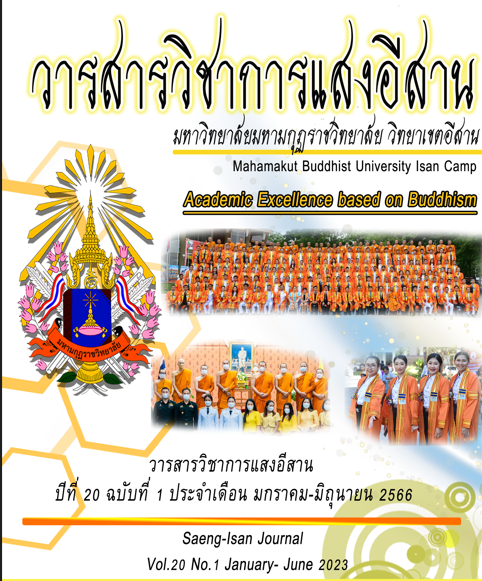การวิจัยเชิงปฏิบัติการแบบมีส่วนร่วม
บทคัดย่อ
บทความนี้มีวัตถุประสงค์นำเสนอการวิจัยเชิงปฏิบัติการแบบมีส่วนร่วม เพื่อให้ทราบความหมาย ความสำคัญ กระบวนการวิจัยเชิงปฏิบัติการแที่เป็นระบบและชัดเจน มีการร่วมกันดำเนินกระบวนการวิจัยโดย ผู้ปฏิบัติงานทุกคนในพื้นที่ กับผู้วิจัยภายนอก มุ่งเน้นให้เกิดการเปลี่ยนแปลงขององค์กร ชุมชน สังคม เพื่อให้ทุกคนมีส่วนร่วมในการเป็นเจ้าของและความรับผิดชอบในผลของการเปลี่ยนแปลงตามวัตถุประสงค์ที่ตั้งไว้ ซึ่งขั้นตอนกระบวนกระบวนการวิจัยเชิงปฏิบัติการแบบมีส่วนร่วม ประกอบด้วย 1) การร่วมเตรียมการ 2) การร่ามวางแผน 3) การร่วมลงมือปฏิบัติ 4) การร่วมสังเกต 5) การร่วมสะท้อนผล 6) การร่วมวางแผนใหม่ 7) การการร่วมลงปฏิบัติใหม่การ 8) การร่วมสังเกต 9) การร่วมวิเคราะห์ผล และ 10) การร่วมสรุปรายงานผลวิจัย
เอกสารอ้างอิง
จิรัชยา เจียวกก และสันติชัย แย้มใหม่. (2559). การวิจัยเชิงปฏิบัติการแบบมีส่วนร่วม ในการพัฒนาชุมชน. สืบค้นจาก https://doi.nrct.go.th//ListDoi/listDetail?Resolve_DOI=10.14456/hyaj.2016.7 สืบค้นเมื่อ 23 พฤศจิกายน 2565
ดนัยรัตน์ กาศเกษม และฉลอง ชาตรูประชีวิน. (2563). การพัฒนาครูสะเต็มในโรงเรียนมัธยมศึกษาด้วยการวิจัยเชิงปฏิบัติการแบบมีส่วนร่วม. สืบค้นจาก https://so05.tci-thaijo.org/index.php/tgt/article/view/243959/165675, สืบค้นเมื่อ 23 พฤศจิกายน 2565
พระราชกฤษฎีกาว่าด้วยหลักเกณฑ์และวิธีการบริหารกิจการบ้านเมืองที่ดี พ.ศ.2546. (9 ตุลาคม 2546). ราชกิจจานุเบกษา เล่ม 124 ตอนที่ 55 ก หน้า 1
พระราชบัญญัติระเบียบบริหารราชการแผ่นดิน (ฉบับที่ 7) พ.ศ.2550. (15 กันยายน 2550). ราชกิจจานุเบกษา. เล่ม 120 ตอนที่ 100 ก หน้าที่ 1 – 16
พิศุทธ์ปภาณ จินะวงค์. (2564). การพัฒนาผลสัมฤทธิ์ทางการเรียนคณิตศาสตร์ เรื่องการคูณโดยใช้แบบฝึกทักษะสำหรับนักเรียนชั้นประถมศึกษาปีที่ 2 โรงเรียนสุเหร่าลาดพร้าว. สืบค้นจาก https://so04.tci-thaijo.org/index.php/lawasrijo/article/view/251375/171454, สืบค้นเมื่อ 23 พฤศจิกายน 2565.
สัญญา ยือราน (2561). การวิจัยเชิงปฏิบัติการแบบมีส่วนร่วม สู่ความสำเร็จการเปลี่ยนแปลงนโยบายในระบบสุขภาพ. สืบค้นจาก https://cuturl.sbs/B2YUYy8, สืบค้นเมื่อ 23 พฤศจิกายน 2565.
สิทธิพร เขาอุ่น และคณะ. (2564). การวิจัยเชิงปฏิบัติการแบบมีส่วนร่วมเพื่อการบริหารจัดการขยะชุมชนฐานราก:องค์การบริหารส่วนตำบลลำพยนต์ อำเภอตากฟ้า จังหวัดนครสวรรค์. สืบค้นจาก https://shorturl.asia/dgoMu, สืบค้นเมื่อ 23 พฤศจิกายน 2565.
สุสารี ประคินกิจ, จรัสดาว เรลโนลด์ และ อรทิพา ส่องศิริ . (2562). การพัฒนารูปแบบการสร้างเสริมสุขภาพจิตในชุมชน ด้วยกระบวนการวิจัยปฏิบัติการแบบมีส่วนร่วม: กรณีศึกษาชุมชนหนึ่ง ในกรุงเทพมหานคร. สืบค้นจาก https://e-library.siam.edu/e-journal/wp-content/uploads/2020/02/Susaree-Prakhinkit-APHEIT-J.-science-8-1-2562.pdf, สืบค้นเมื่อ 23 พฤศจิกายน 2565.
Carr, and Kemmis. (1986). Becoming Critical: Educational, Knowledge and Action Research. London: Falmer
Cohen, J. M., & Uphoff, N. T. (1981). Rural Development Participation: Concept and Measures for Project Design Implementation and Evaluation. Ithaca, NY: Rural Development Committee Center for International Studies, Cornell University.
Denzin, and Lincoln. (1994). Handbook of Qualitative Research. Thousand Oaks: Sage.
Kemmis, and McTaggart. (1990). The action research planner. Geelong: Deakin University Press.
Kurt Lewin. (1946). Action Research and Minority Problems. Journal of Social, Issues 2
Stringer, E. T. (2004). Action research in education. Upper Saddle River, NJ: Prentice-Hall.
White, (1982). Why Community Participation a Discussion of the argument go, Community participation: Current issue and lesson learned. New York: United Nations Children’s Fund
Zuber Skerrit. 1992). Improving learning and teaching through action learning and action research (Draft paper for the HERDSA Conference 1992). University of Queensland
ดาวน์โหลด
เผยแพร่แล้ว
ฉบับ
ประเภทบทความ
สัญญาอนุญาต
ลิขสิทธิ์ (c) 2023 วารสารวิชาการแสงอีสาน

อนุญาตภายใต้เงื่อนไข Creative Commons Attribution-NonCommercial-NoDerivatives 4.0 International License.
เนื้อหาและข้อมูลในบทความที่ตีพิมพ์ในวารสาร ถือเป็นข้อคิดเห็นและความรับผิดชอบของผู้เชียนบทความโดยตรง ซึ่งวารสารไม่มีส่วนเกี่ยวข้อง นอกจากนั้น ผู้เขียนทุกท่านต้องยืนยันว่าบทความต้นฉบับที่ส่งมาตีพิมพ์เผยแพร่นั้น จะต้องไม่เป็นบทความที่กำลังอยู่ในการพิจารณาเพื่อตีพิมพ์ในวารสารอื่นหรือเคยตีพิมพ์เผยแพร่มาแล้ว หากมีการใช้ภาพ ข้อความหรือตารางของผู้เขียนหรือผู้นิพนธ์ท่านอื่น ผู้เขียนจะต้องอ้างแหล่งที่มาหรือเจ้าของลิขสิทธ์
Publication Ethic:
The detail published in Saeng Isan Journal is opinion and responsibility of the authors, and it is not relevant with the jouranl. Besides, the authors must certify that the original manuscript is not in the process to publish in other journals or used to publish in other journals. If the authors use paragraphs, pictures or tables from others, the athours must refer to the original sources.
Article Consideration:
Each article will be published by a panel three journalists with expertise in relevant fields, and get the editorial approval before publishing. The review is in the form of The article's double blind.
To comply with copyright law. The author must sign the copy of the article submission form to the journal. In addition, the author must confirm that the original article submitted to the journal is only one publication in Saeng Isan Journal. If the images or tables of other authors appearing in other publications are used, the author must ask permission of the copyright owner before publishing.


